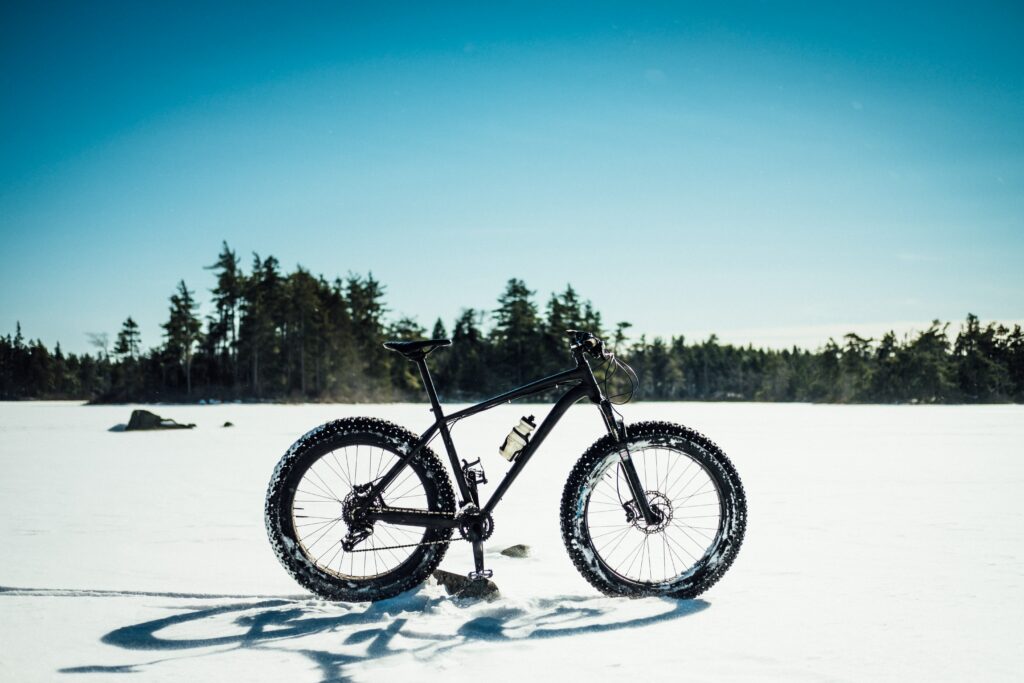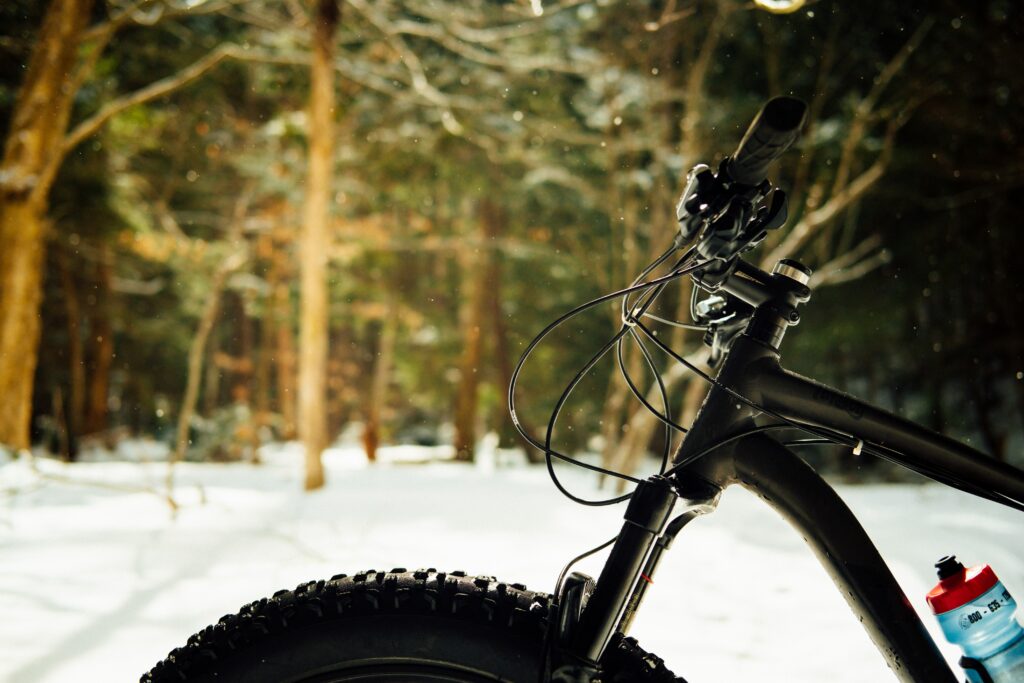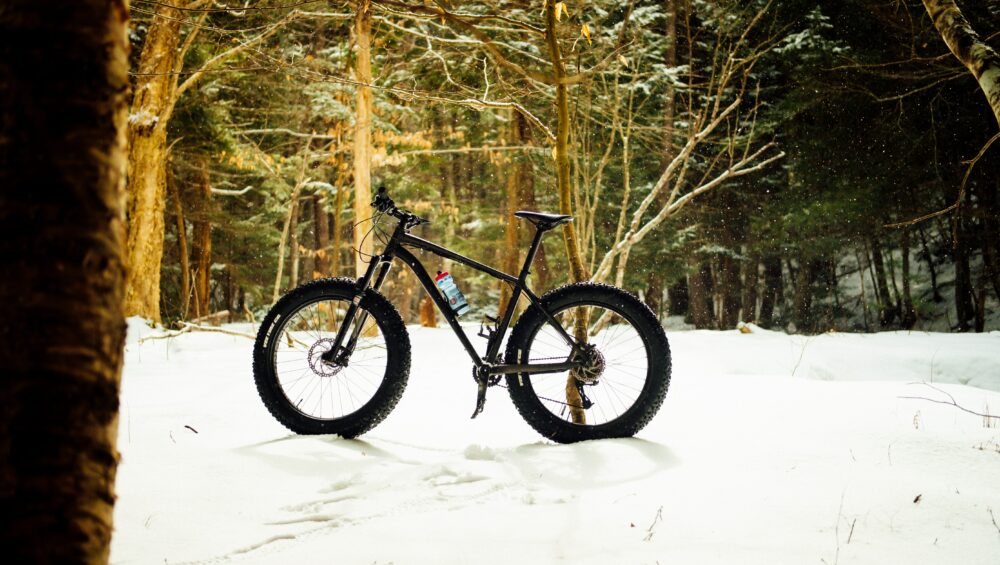The appearance of snow on the ground often covers the dirt tracks that we live to ride during the rest of the year. The disappearing trails will move most to put their mountain bikes away for the season and pull out skis or snowboards as a replacement. What many people can often look past is the joy of mountain biking in the snow and how it brings an entirely different level of enjoyment to the sport.
Winter mountain biking can be challenging for those who struggle with the cold. Many recent trends point towards needing a fat tire bike to go out biking in the snow. Fortunately, you don’t need to make a considerable purchase to go out riding all winter long. With the right precautions and winter biking tips, you can spend beautiful snowy and bluebird days on your bike doing what you love most.

Keep a good attitude
First and foremost, keep your spirits high. Of all the winter biking tips you read, keeping a smile on your face and a resilient attitude will be the most important.
Your winter ride will be slower and most likely filled with a fair number of falls and slides that will get you cold and wet. Regardless, this can be the most fun you’ll have all winter if you remember to keep smiling and focus on the positive.
Lower your tire pressure
If you’re feeling strapped for cash or want to try mountain biking in the snow without spending a huge amount of money on a fat tire bike, you can start by letting some air out of your tires. Take a look at the sidewall of your tires and find the lower number on the pressure range, then drain the tires to that level.
You’re going for more surface area and contact between your tires and the ground. One great way to do this is to lower your tire pressure and let the tires sag a bit more, and hug the ground.
The biggest thing to look out for when flattening your tires is pinch flats. A great way to avoid this easy problem is to go tubeless. Tubeless tires are relatively new, and replacing the tube with a sealant makes getting a flat much harder. Not only is that great for lower tire pressure, it means you’re much less likely to get stranded on a snowy trail in the middle of winter!
Widen your tires
Winter mountain biking may be your next big sport, and you may feel that it’s worth it to invest. In that case, buying a fat tire bike is the best way to truly enjoy the snowy drifts that the winter months have to offer.
The wide tires on these rigs allow for more surface contact between the bike and the snow. That way, you’re able to float on deeper powder and slide less. It’s pretty much guaranteed that you’ll slide around a bit while biking in the snow, but this way, you can control it some more.
That being said, fat-tire bikes are expensive. They aren’t totally necessary, and you can bike without them. They’re also incredibly fun to ride and shift the experience to a much easier ride.

Opt for flat pedals
Clip-in pedals aren’t the best option for cruising on slippery trails. You’re going to do some sliding, which means you’ll need the option of throwing a foot down for stability much more often and faster than normal. With flat pedals, you can get a foot in position quickly and keep yourself upright.
Steel-pin flat pedals allow for the extra grip that is mighty helpful in the slick and icy winter. They’ll give you plenty of traction and the ability to dismount. They also allow for a lot more space, which means the potential for bigger, warmer boots is there. Even riding at your hardest, it’s likely to result in cold extremities if you’re tackling trails in the dead of winter.
Pay attention to trail conditions
One of the most important parts of riding in the snow is getting to know what you’re riding. True, you can go out and check the trail conditions firsthand, but you may want to save yourself some time and choose the right trail from the start.
With winter mountain biking being one of the most popular winter activities in Colorado Springs, you’ll be able to find loads of trail information on the web. Mountain biking forums and Facebook groups will certainly have someone on them that has checked out the trail before you have. Use their experience to your advantage and look around before throwing your bike on the car and heading out.
What you’re looking for is a beautiful snowpack that either allows easier access to the ground or a hard pack of snow. In the middle of winter, you’ll be more likely to find the latter.
Two to three inches of powder is ideal for biking in the snow. It gives you a nice layer of snow to cruise through but allows some interaction with the ground. As it starts to warm up or the snow gets too soft, you may spend more time picking yourself up than biking. The softer the snow, the more your bike turns into a sled.
Trails that take you on a cruise and slightly hilly rides are much better than those that demand steep climbs and fast, aggressive descents. You’ll find your tires slipping as you push to climb, and the moment you hit an icy patch on the descent will be the end of your riding for the day. Choose a moderate trail that will let you stay on flatter terrain.





